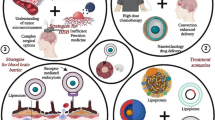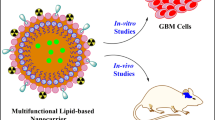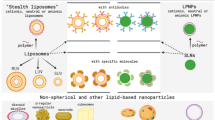Abstract
Purpose
Malignant cerebral tumors have poor prognosis and the blood–brain barrier is a major hindrance for most drugs to reach those tumors. Lipid nanoparticles (LDE) that bind to lipoprotein receptors may carry anticancer drugs and penetrate the cells through those receptors that are overexpressed in gliomas. The aim was to investigate the in vivo uptake of LDE by human cerebral tumors.
Methods
Twelve consecutive patients (4 with glioblastomas, 1 meduloblastoma, 1 primary lymphoma, 2 with non-cerebral metastases and 4 with benign tumors) scheduled for tumor excision surgery were injected intravenously, 12 h before surgery, with LDE labeled 14C-cholesterol oleate. Fragments of tumors and of normal head tissues (muscle, periosteum, dura mater) discarded by the surgeon were submitted to lipid extraction and radioactive counting.
Results
Tumor LDE uptake (range: 10–283 d.p.m./g of tissue) was not lower than that of normal tissues (range: 20–263 d.p.m./g). Malignant tumor uptake was threefold greater than benign tumor uptake (140 ± 93 vs 46 ± 18 d.p.m./g, p < 0.05). Results show that LDE can concentrate in brain malignant tumors and may be used to carry drugs directed against those tumors.
Conclusion
As LDE was previously shown to markedly decrease drug toxicity this new therapeutic strategy should be tested in future trials.


Similar content being viewed by others
References
Ostrom QT, Gittleman H, Fulop J, Liu M, Blanda R, Kromer C, Wolinsky Y, Kruchko C, Barnholtz-Sloan JS (2015) CBTRUS Statistical Report: Primary Brain and Central Nervous System Tumors Diagnosed in the United States in 2008–2012. Neuro Oncol 17 Suppl 4 (Suppl 4):iv1–iv62. https://doi.org/10.1093/neuonc/nov189.
Arvanitis CD, Ferraro GB, Jain RK (2020) The blood-brain barrier and blood-tumour barrier in brain tumours and metastases. Nat Rev Cancer 20:26–41. https://doi.org/10.1038/s41568-019-0205-x
Maranhão RC, Garicochea B, Silva EL, Llacer PD, Pileggi FJ, Chamone DA (1992) Increased plasma removal of microemulsions resembling the lipid phase of low-density lipoproteins (LDL) in patients with acute myeloid leukemia: a possible new strategy for the treatment of the disease. Braz J Med Biol Res 25:1003–1007
Ruan C, Liu L, Lu Y, Zhang Y, He X, Chen X, Zhang Y, Chen Q, Guo Q, Sun T, Jiang C (2018) Substance P-modified human serum albumin nanoparticles loaded with paclitaxel for targeted therapy of glioma. Acta Pharm Sin B 8(1):85–96. https://doi.org/10.1016/j.apsb.2017.09.008
Zhang W, Huang Z, Pu X, Chen X, Yin G, Wang L, Zhang F, Gao F (2020) Fabrication of doxorubicin and chlorotoxin-linked Eu-Gd2O3 nanorods with dual-model imaging and targeted therapy of brain tumor. Chin Chem Lett 31(1):285–291. https://doi.org/10.1016/j.cclet.2019.04.018
Maranhão RC, Garicochea B, Silva EL, Dorlhiac-Llacer P, Cadena SM, Coelho IJ, Meneghetti JC, Pileggi FJ, Chamone DA (1994) Plasma kinetics and biodistribution of a lipid emulsion resembling low-density lipoprotein in patients with acute leukemia. Cancer Res 54:4660–4666
Mahley RW (2017) Apolipoprotein E: remarkable protein sheds light on cardiovascular and neurological diseases. Clin Chem 63:14–20. https://doi.org/10.1373/clinchem.2016.255695
Maranhão RC, Cesar TB, Pedroso-Mariani SR, Hirata MH, Mesquita CH (1993) Metabolic behavior in rats of a nonprotein microemulsion resembling low-density lipoprotein. Lipids 28:691–696. https://doi.org/10.1007/BF02535988
Pires LA, Hegg R, Valduga CJ, Graziani SR, Rodrigues DG, Maranhão RC (2009) Use of cholesterol-rich nanoparticles that bind to lipoprotein receptors as a vehicle to paclitaxel in the treatment of breast cancer: pharmacokinetics, tumor uptake and a pilot clinical study. Cancer Chemother Pharmacol 63:281–287. https://doi.org/10.1007/s00280-008-0738-2
Dias MLN, Carvalho JP, Rodrigues DG, Graziani SR, Maranhão RC (2007) Pharmacokinetics and tumor uptake of a derivatized form of paclitaxel associated to a cholesterol-rich nanoemulsion (LDE) in patients with gynecologic cancers. Cancer Chemother Pharmacol 59:105–111. https://doi.org/10.1007/s00280-006-0252-3
Maranhão RC, Graziani SR, Yamaguchi N, Melo RF, Latrilha MC, Rodrigues DG, Couto RD, Schreier S, Buzaid AC (2002) Association of carmustine with a lipid emulsion: in vitro, in vivo and preliminary studies in cancer patients. Cancer Chemother Pharmacol 49:487–498. https://doi.org/10.1007/s00280-002-0437-3
Hungria VT, Latrilha MC, Rodrigues DG, Bydlowski SP, Chiattone CS, Maranhão RC (2004) Metabolism of a cholesterol-rich microemulsion (LDE) in patients with multiple myeloma and a preliminary clinical study of LDE as a drug vehicle for the treatment of the disease. Cancer Chemother Pharmacol 53:51–60. https://doi.org/10.1007/s00280-003-0692-y
Lo Prete AC, Maria DA, Rodrigues DG, Valduga CJ, Ibañez OC, Maranhão RC (2006) Evaluation in melanoma-bearing mice of an etoposide derivative associated to a cholesterol-rich nano-emulsion. J Pharm Pharmacol 58:801–808. https://doi.org/10.1211/jpp.58.6.0010
Pinheiro KV, Hungria VT, Ficker ES, Valduga CJ, Mesquita CH, Maranhão RC (2006) Plasma kinetics of a cholesterol-rich microemulsion (LDE) in patients with Hodgkin’s and non-Hodgkin’s lymphoma and a preliminary study on the toxicity of etoposide associated with LDE. Cancer Chemother Pharmacol 57:624–630. https://doi.org/10.1007/s00280-005-0090-8
Rodrigues DG, Maria DA, Fernandes DC, Valduga CJ, Couto RD, Ibañez OC, Maranhão RC (2005) Improvement of paclitaxel therapeutic index by derivatization and association to a cholesterol-rich microemulsion: in vitro and in vivo studies. Cancer Chemother Pharmacol 55:565–576. https://doi.org/10.1007/s00280-004-0930-y
Graziani SR, Vital CG, Morikawa AT, Van Eyll BM, Fernandes Junior HJ, Kalil Filho R, Maranhão RC (2017) Phase II study of paclitaxel associated with lipid core nanoparticles (LDE) as third-line treatment of patients with epithelial ovarian carcinoma. Med Oncol 34:151. https://doi.org/10.1007/s12032-017-1009-z
Pawar S, Koneru T, McCord E, Tatiparti K, Sau S, Iyer AK (2021) LDL receptors and their role in targeted therapy for glioma: a review. Drug Discov Today 26:1212–1225. https://doi.org/10.1016/j.drudis.2021.02.008
Dehouck B, Dehouck MP, Fruchart JC, Cecchelli R (1994) Upregulation of the low density lipoprotein receptor at the blood-brain barrier: intercommunications between brain capillary endothelial cells and astrocytes. J Cell Biol 126:465–473. https://doi.org/10.1083/jcb.126.2.465
Dehouck B, Fenart L, Dehouck MP, Pierce A, Torpier G, Cecchelli R (1997) A new function for the LDL receptor: transcytosis of LDL across the blood-brain barrier. J Cell Biol 138:877–889. https://doi.org/10.1083/jcb.138.4.877
Herda LM, Polo E, Kelly PM, Rocks L, Hudecz D, Dawson KA (2014) Designing the future of nanomedicine: current barriers to targeted brain therapeutics. Eur J Nanomed 6:127–139. https://doi.org/10.1515/ejnm-2014-0022
Arcella A, Palchetti S, Digiacomo L, Pozzi D, Capriotti AL, Frati L, Oliva MA, Tsaouli G, Rota R, Screpanti I, Mahmoudi M, Caracciolo G (2018) Brain targeting by liposome-biomolecular corona boosts anticancer efficacy of temozolomide in glioblastoma cells. ACS Chem Neurosci 9:3166–3174. https://doi.org/10.1021/acschemneuro.8b00339
Tashima T (2020) Smart strategies for therapeutic agent delivery into brain across the blood-brain barrier using receptor-mediated transcytosis. Chem Pharm Bull (Tokyo) 68:316–325. https://doi.org/10.1248/cpb.c19-00854
Folch J, Lees M, Sloane Stanley GH (1957) A simple method for the isolation and purification of total lipides from animal tissues. J Biol Chem 226:497–509
Vañó E, Rosenstein M, Liniecki J, Rehani MM, Martin CJ, Vetter RJ (2009) ICRP Publication 113. Education and training in radiological protection for diagnostic and interventional procedures. Ann ICRP 39:7–68. https://doi.org/10.1016/j.icrp.2011.01.002
Mello SB, Tavares ER, Bulgarelli A, Bonfá E, Maranhão RC (2013) Intra-articular methotrexate associated to lipid nanoemulsions: anti-inflammatory effect upon antigen-induced arthritis. Int J Nanomed 8:443–449. https://doi.org/10.2147/IJN.S29
Walter FR, Santa-Maria AR, Mészáros M, Veszelka S, Dér A, Deli MA (2021) Surface charge, glycocalyx, and blood-brain barrier function. Tissue Barriers 9(3):1904773. https://doi.org/10.1080/21688370.2021.1904773
Hersh AM, Alomari S, Tyler BM (2022) Crossing the blood-brain barrier: advances in nanoparticle technology for drug delivery in neuro-oncology. Int J Mol Sci 23(8):4153. https://doi.org/10.3390/ijms23084153.392
Sun T, Jiang X, Wang Q, Chen Q, Lu Y, Liu L, Zhang Y, He X, Ruan C, Zhang Y, Guo Q, Liu Y, Jiang C (2017) Substance P mediated DGLs complexing with DACHPt for targeting therapy of glioma. ACS Appl Mater Interfaces 9(40):34603–34617. https://doi.org/10.1021/acsami.7b05997
Lu VM, McDonald KL, Townley HE (2017) Realizing the therapeutic potential of rare earth elements in designing nanoparticles to target and treat glioblastoma. Nanomedicine (Lond) 12(19):2389–2401. https://doi.org/10.2217/nnm-2017-0193
Hwang SR, Kim K (2014) Nano-enabled delivery systems across the blood–brain barrier. Arch Pharm Res 37:24–30. https://doi.org/10.1007/s12272-013-0272-6
Lane-Donovan C, Philips GT, Herz J (2014) More than cholesterol transporters: lipoprotein receptors in CNS function and neurodegeneration. Neuron 83:771–787. https://doi.org/10.1016/j.neuron.2014.08.005
Hayashi H (2011) Lipid metabolism and glial lipoproteins in the central nervous system. Biol Pharm Bull 34:453–461. https://doi.org/10.1248/bpb.34.453
Pitas RE, Boyles JK, Lee SH, Hui D, Weisgraber KH (1987) Lipoproteins and their receptors in the central nervous system. Characterization of the lipoproteins in cerebrospinal fluid and identification of apolipoprotein B, E (LDL) receptors in the brain. J Biol Chem 262(29):14352–60
Rudling MJ, Angelin B, Peterson CO, Collins VP (1990) Low-density lipoprotein receptor activity in human intracranial tumors and its relation to the cholesterol requirement. Cancer Res 50(3):483–487
Goldstein JL, Brown MS (2009) The LDL receptor. Arterioscler Thromb Vasc Biol 29:431–438. https://doi.org/10.1161/ATVBAHA.108.179564
Herz J, Hamann U, Rogne S, Myklebost O, Gausepohl H, Stanley KK (1988) Surface location and high affinity for calcium of a 500-kd liver membrane protein closely related to the LDL-receptor suggest a physiological role as lipoprotein receptor. EMBO J 7:4119–4127. https://doi.org/10.1002/j.1460-2075.1988.tb03306.x
Herz J, Kowal RC, Goldstein JL, Brown MS (1990) Proteolytic processing of the 600 kd low density lipoprotein receptor-related protein (LRP) occurs in a trans-Golgi compartment. EMBO J 9:1769–1776. https://doi.org/10.1002/j.1460-2075.1990.tb08301.x
Kanekiyo T, Bu G (2014) The low-density lipoprotein receptor-related protein 1 and amyloid-β clearance in Alzheimer’s disease. Front Aging Neurosci 6:93. https://doi.org/10.3389/fnagi.2014.00093
Zhao Y, Li D, Zhao J, Song J, Zhao Y (2016) The role of the low-density lipoprotein receptor–related protein 1 (LRP-1) in regulating blood-brain barrier integrity. Rev Neurosci 27:623–634. https://doi.org/10.1515/revneuro-2015-0069
Calvo D, Vega MA (1993) Identification, primary structure, and distribution of CLA-1, a novel member of the CD36/LIMPII gene family. J Biol Chem 268:18929–18935
Acton SL, Scherer PE, Lodish HF, Krieger M (1994) Expression cloning of SR-BI, a CD36-related class B scavenger receptor. J Biol Chem 269:21003–21009
Calvo D, Gomez-Coronado D, Lasuncion MA, Vega MA (1997) CLA-1 is an 85-kD plasma membrane glycoprotein that acts as a high-affinity receptor for both native (HDL, LDL, and VLDL) and modified (OxLDL and AcLDL) lipoproteins. Arterioscler Thromb Vasc Biol 17:2341. https://doi.org/10.1161/01.atv.17.11.2341
Shen WJ, Azhar S, Kraemer FB (2018) SR-B1: a unique multifunctional receptor for cholesterol influx and efflux. Annu Rev Physiol 80:95–116. https://doi.org/10.1146/annurev-physiol-021317-121550
Zheng Y, Liu Y, ** H, Pan S, Qian Y, Huang C, Zeng Y, Luo Q, Zeng M, Zhang Z (2013) Scavenger receptor B1 is a potential biomarker of human nasopharyngeal carcinoma and its growth is inhibited by HDL-mimetic nanoparticles. Theranostics 3:477–486. https://doi.org/10.7150/thno.6617
Jia J, **ao Y, Liu J, Zhang W, He H, Chen L, Zhang M (2012) Preparation, characterizations, and in vitro metabolic processes of paclitaxel-loaded discoidal recombinant high-density lipoproteins. J Pharm Sci 101:2900–2908. https://doi.org/10.1002/jps.23210
Foit L, Giles FJ, Gordon LI, Thaxton CS (2015) Synthetic high-density lipoprotein-like nanoparticles for cancer therapy. Expert Rev Anticancer Ther 15:27–34. https://doi.org/10.1586/14737140.2015.990889
Goodman LS, Brunton LL, Chabner B, Knollmann BC (2011) Goodman & Gilman’s pharmacological basis of therapeutics. McGraw-Hill, New York
Gillmore JD, Gane E, Taubel J, Kao J, Fontana M, Maitland ML, Seitzer J, O’Connell D, Walsh KR, Wood K, Phillips J, Xu Y, Amaral A, Boyd AP, Cehelsky JE, McKee MD, Schiermeier A, Harari O, Murphy A, Kyratsous CA, Zambrowicz B, Soltys R, Gutstein DE, Leonard J, Sepp-Lorenzino L, Lebwohl D (2021) CRISPR-Cas9 in vivo gene editing for transthyretin amyloidosis. N Engl J Med 385:493–502. https://doi.org/10.1056/NEJMoa2107454
Tedesco AC, Silva EPO, Jayme CC, Piva HL, Franchi LP (2021) Cholesterol-rich nanoemulsion (LDE) as a novel drug delivery system to diagnose, delineate, and treat human glioblastoma. Mater Sci Eng C 123:111984. https://doi.org/10.1016/j.msec.2021.111984
Acknowledgements
This study was supported by the São Paulo Research Support Foundation (FAPESP), National Council for Scientific and Technological Development (CNPq), and the National Institute of Science and Technology Complex Fluids (INCT-FCx). Dr. Maranhão holds an A-1 Research Carrier Award from CNPq.
Funding
This study was supported by the São Paulo Research Support Foundation (FAPESP, grant number 2014/03742–0, Brazil), National Council for Scientific and Technological Development (CNPq, grant 431290/2016–4, Brasilia, Brazil).
Author information
Authors and Affiliations
Contributions
Conceptualization and project administration: ELRP and RCM; methodology: DFD, ELRP, and RCM; formal analysis: ELRP and RCM; investigation: ELRP, DCAF, JPLT, and NMM; data curation: ELRP, DCAF, DFD, and RCM; writing—original draft preparation: ERT, CGV, ELRP, and RCM; writing—review and editing: ERT and CGV; supervision and funding acquisition: RCM.
Corresponding author
Ethics declarations
Competing interests
The authors have no relevant financial or non-financial interests to disclose.
Ethical approval
This study was approved by the Ethics Committee of the Federal University of Pará (CAAE 98117312.2.0000.0017). All subjects signed informed consent form in accordance with the Declaration of Helsinki.
Additional information
Publisher's Note
Springer Nature remains neutral with regard to jurisdictional claims in published maps and institutional affiliations.
Rights and permissions
About this article
Cite this article
Pereira, E.L.R., Feio, D.C.A., Tavares, J.P.L. et al. Uptake of lipid core nanoparticles by fragments of tissues collected during cerebral tumor excision surgeries: hypotheses for use in drug targeting therapy. J Neurooncol 158, 413–421 (2022). https://doi.org/10.1007/s11060-022-04028-1
Received:
Accepted:
Published:
Issue Date:
DOI: https://doi.org/10.1007/s11060-022-04028-1




